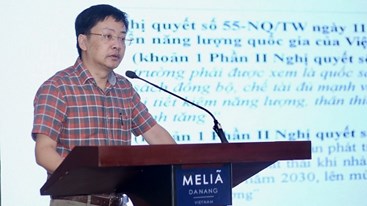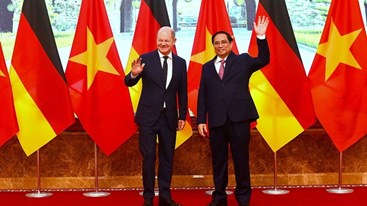Saturday, 05/10/2024 | 19:17 GMT+7
Usually, to build a kiln for producing traditional bricks, about 30,000 hectares of arable land, equivalent to the area of a commune, are needed. Moreover, normal bricks require a lot of coal, fuel wood for heating and also produce smoke causing severe air pollution. Therefore, using non-fired eco brics is regarded as an effective solution which will bring great benefits for the economy, saving the natural resources and environment. There have been quite a few clear-headed entrepreneurs anticipating the trend of non-fired eco bricks in building and taking the first steps into the field.
The first building construction using non-fired
building materials in Ha Noi is the Keang Nam 70-storied building. The owner of
this project has transported the entire discarded constructional materials and
soil from digging the foundation to Hue Quang Commerce and Technology Joint
stock company (Hue Quang Company). This company will buy the discarded soil
from Keang

Meanwhile, the market for exchanging eco brick technology in
These technologies mainly originate from Russia and China but there are also technologies which came from successful research of domestic scientists, for example: the MFGV-7.0 large capacity non fired eco brick automatic production line designed and developed by scientists and engineers of the Hanoi University of Technology; or the "From Land to Stone" production line and equipment for producing non-fired bricks manufactured by Hue Quang Company cooperating with expert engineering groups from the Institute of Machinery and industrial tools (Ministry of Industry and Trade). The costs of these devices only equal to half the price of imported production lines, but their products’ quality still meets all the technical standards for construction materials.
According to Mr. Nguyen Van Quy – Director of Hue Quang Company, "non-fired bricks are capable of withstanding temperatures up to 9,500 degrees Celsius. After the bricks have been pressed and shaped, we only have to wait for just 7-10 days for drying before they are ready to be used. Furthermore, with the production line capable of producing 15 million bricks per year, it is possible to reduce carbon dioxide emission by 5,000 tons (as no coal is needed for heating bricks). In addition, raw materials for producing bricks can be taken from different types of soil, from non-arable hill land, coastal plain land to the construction waste or industrial waste."
In order to bring sustainable development and practical benefits for the economy and environment with non-fired eco bricks, Hue Quang Company is currently cooperating with Consulting and Commercial Investment Ltd. Company (Intraco) to execute the Mechanism of clean development (PoA – CDM) for non-fired eco brick projects. However, because of the very big implementation costs of about USD100,000 for a project, the two sides are considering another approach of building a big project consisting of a set of small scaled CDM projects in different locations. If the project is successful, the manufacturers will receive a significant profit from selling certificates of low carbon emission; especially when they have not had to pre-pay for the consulting costs of CDM projects yet but only after receiving the money from selling low emission certificates.
In short, using non-fired eco bricks will not only save land resource, especially arable land, but also contribute to environment preservation and energy saving. With capacity of producing 10 cubic meters of clay per hour, equivalent to 8 thousand bricks, the whole process only consumes about 40 kWh, saving a significant amount of energy compared with normal bricks – over 80%. According to energy efficiency experts, there is no other production field able to save such a high proportion of energy, not mentioning the fact that it also saves land resources, reuse discarded constructional materials and industrial waste, as well as brings environmental and health benefits for the workers.
In addition, with superior advantages such as light weight, moisture-proof, sound-proof, smooth surface, non-fired eco brick also helps save time and material for refining the surface of the building, thus there have been an increasing number of enterprises investing in eco brick production technology.
However, only a small number of enterprises who have signed contracts with foreign investors are confident enough to invest in extending production, because at the moment the Ministry of Construction has yet to provide regulations and technical standards, which leads to difficulties in accounting with investors, whereas other major projects like Keang Nam Building, Hanoi Landmark Tower, Horizon Hotel, Ha Dong – Europe Village of Vietnamese expatriates, Habico Tower, etc always have preference for non-fired constructional materials. Moreover, the majority of domestic enterprises often produces and transfers technology at the same time, leading to overlapped development strategies as well as production scale. So far a few companies have actively invested in building production lines for non-fired constructional materials, e.g. Tan Ky Nguyen Building Brick JSC (Long An), projects of Song Da 12 company, Constructional Glass and Ceramic Corporation, etc.
In order to create favorable conditions for developing the sector of producing non-fired building materials, in addition to tax incentives, loan supports for ground investment, the Ministry of Construction also has a plan of building complete solutions for enhancing production technology to support enterprises in investing non-fired building material. Besides, the Ministry has pledged to examine, complete and publish as soon as possible a comprehensive system of regulations, technical standards, instructional document in building process and economical – technical norms related to the production and application of non-fired building materials.
Along with the growth of the economy, the construction industry is constantly adding value. The decision to use non-fired eco bricks for constructional buildings is a suitable development strategy in accordance with the national guideline for industrialization and modernization of the economy, and also shows the responsibilities of businesses and social communities with their environment, not only for today but for the long term benefits.
By Nguyen An







.png?w=367&h=206&mode=crop)
 Energy efficiency and conservation measures for industrial enterprises
Energy efficiency and conservation measures for industrial enterprises
 EOI Extension (#3): C2.2.2: Review and update for current EE benchmarking for 2 sub-industrial sectors
EOI Extension (#3): C2.2.2: Review and update for current EE benchmarking for 2 sub-industrial sectors
.jpg?w=367&h=206&mode=crop) Technical Consultation on Energy Usage Standards Amendment in the Steel Industry
Technical Consultation on Energy Usage Standards Amendment in the Steel Industry
.jpg?w=367&h=206&mode=crop) Paper Industry's Efforts to Save Energy
Paper Industry's Efforts to Save Energy
 National Conference on Energy Efficiency and Conservation 2024
National Conference on Energy Efficiency and Conservation 2024
 Enhancing Awareness of Energy Management Systems and System Optimization
Enhancing Awareness of Energy Management Systems and System Optimization
 Efficient and Economical Energy Use in Wood Production
Efficient and Economical Energy Use in Wood Production